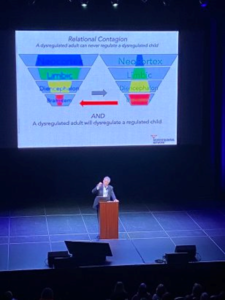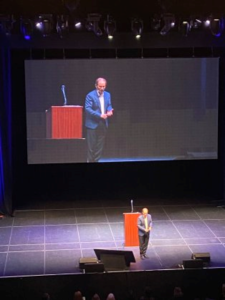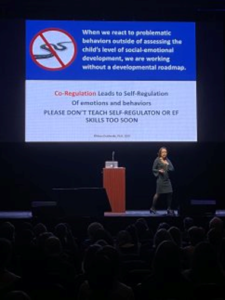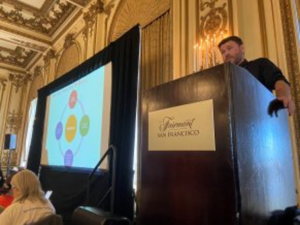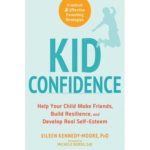I had planned to write a post describing our most recent conference, last weekend in San Francisco (“where every day is cardio day”).
However, one of our attendees — Mark Barrett — got there first. I thought he did such a good job of summarizing so many of the speakers that you’d enjoy reading his words.
Thankfully, Mark agreed to let me copy his post here. I also encourage you to check out his blog, “Education Rumination.”
This past Family Day long weekend, my admin partner, Rupi and I headed down to San Francisco for the Learning and the Brain Conference. This 55th edition of the Conference was themed, Educating Anxious Minds, and had a record-setting 2500 participants attend from around North America and beyond. The inspiration for the conference came as a result of recent reports finding that many children and teens are experience significant stress, anxiety, and mental health issues. The purpose was to help education professionals reduce anxiety and stress in schools; address teen depression and challenging classroom behaviours; foster coping skills and mindful practices; create trauma-sensitive schools; and improve school success by prompting positive teacher-student relationships.
As the Professional Development Chair for the North Vancouver Administrators Association, this conference was particularly relevant for me on a couple of fronts. Firstly, I am in the midst of organizing our annual Administrators Conference in Whistler, and our theme for 2020 is the BCPVPA domain of Relational Leadership. Many of the speakers touched on how school-based administrators can positively impact school climate, culture and student anxiety through instructional care models that support staff. High relational leadership capacity is certainly an integral aspect of any successful care model. Secondly, in my same role as NovA Pro-D Chair, I’ve created a network of 5 different book clubs for my colleagues. One of the books being read, The Boy Who Was Raised as a Dog, was authored by the first keynote speaker, Dr. Bruce Perry, and it was enlightening to hear his behavioural science-based approach to understanding anxious students.
Bruce Perry
Throughout the conference I attempted to live-Tweet to my professional network some of the best sound bites. Many of my favourite take-aways were from one of the first keynotes, By Dr. Perry. Among them included:
- “Our primary work in the classroom is to first regulate the child, or else you can’t connect with them. Humans are relational creatures.”
- The key to a trauma-informed classroom is to recognize there needs to be differential dosing of curricular content based on the needs of the child.
- “A regulated classroom is a rhythmic classroom and a relational classroom. If you stay calm, it will calm them (students) down.”
- “Administrators need to think about instructional care models.” Because a dysregulated adult can never regular a dysregulated child.
Dr. Perry’s talk hit many of the themes that would be highlighted throughout the conference, including that when we attend to the wellness of adults who care for children, we are better positioned to tend to the wellness of students, and that relationships are key to everything, including the personalization of learning.
Dan Siegel
Dr. Dan Siegel was also a highlight speaker for me, and I was pleased to have the opportunity hear him speak not once, but twice. As a neuropsychiatrist, I appreciated hearing from a perspective grounded in neural science. One of the key phrases he used was, “Where attention goes, neural firing flows and neural connection grows.” Essentially what this means is that the adolescent brain goes through a process of pruning some neural networks, and enhancing others by laying down myelin. We strengthen the neural networks we use, and lose those we don’t. The lesson for educators here is to encourage students in devoting their energies towards those networks they want to build and enhance; to pursue their areas of passion and routines that reinforce health and wellness.
One of the more amusing anecdotes was about the development of the teenage brain in comparison to other adolescent species. Dr. Siegel described how adolescent gazelles will also engage in risky behaviour by running up to their natural predators and then running away. While this may, on the surface, seem exceptionally foolish, Dr. Siegel explained that the ability to lead is enhanced when one has been to the precipice of danger and navigated back from it successfully.
Adolescence is also the time when many species begin pushing for their own independence, and look to leave the relative comfort of, what Dr. Siegel calls, “The Oatmeal House”. (The home where your parents prepare your oatmeal for you every morning! And do your laundry… and pay the bills, etc. etc). As adolescents prepare to leave the safety of the family collective, social acceptance among their peer group becomes vitally important; so much so that they will cave to peer pressure to gain it and may even act contrary to their values or morals. From a neuro-science perspective, however, this is actually a survival instinct; because without the safety of the group, those left on the outside looking in have their entire existence jeopardized.
Other gems from Dr. Siegel included:
- The ‘3 Rs’ of Reading, Writing and Arithmetic are important, but it’s important to also teach the ‘new’ 3 Rs: Reflective skills, Relationship skills, Resilience skills. My colleague Brad Baker also suggested an additional R; ‘Respect’.
- Defining what ‘integration’ means with respect to relationships and the brain. Integration is where different aspects of a system become linked, but don’t lose their uniqueness. Integrative relationships stimulate the growth of the integrated brain, leading to regulation and optimal health. Adversity, conversely, impairs brain integration.
- The identification of ‘4 Ss’ that help promote an integrative brain and, by extension, health and well-being: Safety, being Seen (students need to noticed), Soothed (fears), Security (trust).
- F.A.C.E.S. is an acronym used to characterize the features of wellbeing: Flexible, Adaptive, Coherence, Energized, Stable
Other Great Speakers
Two other speakers I enjoyed listening to included Dr. Mona Delahooke’s talk on Using Brain Science to Reduce Anxiety, Toxic Stress, and Behavioural Challenges and Clay Cook’s breakout session on Teacher Stress & Wellbeing.
Dr. Delahooke, in her empathic approach, suggested that challenging student behaviours are an adaption to autonomic nervous system cues, and that there is a difference between wilful misbehaviour and a subconscious adaptation. The behaviours are only the metaphorical tip of the iceberg, and that it’s our responsibility in caring for our children to delve beyond the surface, seek to understand, and support students as best we can. I also appreciated Dr. Delahooke’s notion that self-regulation needs to begin first with co-regulation; that the external interaction between students in your classroom/building needs to be upskilled and regulated before attention can be turned inwards for students.
Clay Cook’s breakout session about Promoting Teacher’s Stress Reduction, Emotional Wellbeing, and Positive Social Interactions, really hammered home the theme that unwell adults have difficulty promoting well children. He also discussed how psychological safety for staff creates a collaborative and innovative learning culture, and that ‘climate’ is how people feel, while ‘culture’ is how people behave. Finally, Clay noted that high-performing environments and frequent ‘ratcheting-up’ of expectations for students are a potent risk factor for mental health disorders, just as other factors like poverty are. This idea gave me pause for reflection on how it is we can continue to maintain high expectations and the pursuit of excellence in our students, while simultaneously supporting their mental health and wellbeing.
Overall the conference was a wonderful learning experience, and I found the speakers to generally be highly engaging, knowledgeable and informative. My notes here represent only a handful of the many talented presenters we saw. In the end, I left having a better understanding of some of the latest science-based research supporting the work we’re already doing with our students around mental health and wellness, and a renewed appreciation for the commitment I have to building the best relationships I can both with and among my staff. Lastly, it was also a great opportunity to network with education professionals from the U.S., Canada and beyond. If you’re considering attending one of the bi-annual Learning and Brain Conferences in either San Francisco or New York, I would highly recommend that you do!
Mark Barrett
Editor’s note: we also have a conference in Boston every fall. We hope you’ll be able to join us — and Mark — soon!

